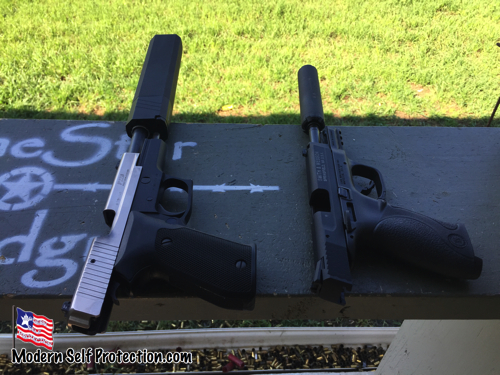
A couple weeks ago, I went to the local range with a friend because he had two new suppressors to shoot. I can’t ever deny a range trip, so I went.
First off: It’s a damned silencer, too. The words are interchangeable. The legal term is a suppressor as defined by the ATF and the National Firearms Act (NFA) of 1934. The NFA officially created the legal term suppressor. But Hiram Maxim (the son of Hiram Maxim that invented the machine gun) built the first one for sale around 1902 and called it a silencer and even trade marked it a “Maxim Silencer”. So calling it a silencer would be historically correct (and if you want to be tacticool, you can call it a “can”). Ironically Maxim also developed one of the first car mufflers at about the same time as the silencer (because they work the same way). Really, don’t worry about what it’s called, go shoot one, it’s fun.
I was able to shoot two different suppressors on three different guns and three different calibers. One of the big secrets of suppressors is that you can buy one for a bigger caliber and then shoot it on a smaller caliber. You can buy a silencer for a .308 and use it on your .308/7.62 and your .556 and anything smaller than a .30 caliber. The effectiveness of the silencer goes down when you use it on smaller calibers, but it still works.
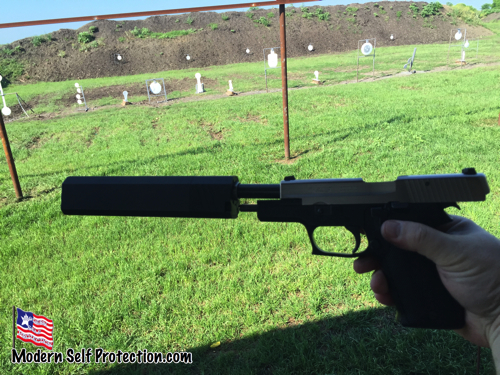
The first silencer I played with was an Osprey 45. The Osprey from Silencer Co. is different than most and looks different. It doesn’t have the traditional “can” shape. It is more oval. The can screws onto the barrel on top of the oval and the extra hangs down below the gun.
With a silencer, seeing your sights is always an issue. Further complicating that is the general rule that the more volume (size) the can has the better it works (more it cuts noise). No suppressor is perfect; they just cut the noise a lot. So the Osprey lets some of that size hang down to the bottom to get more volume to make it quieter, but still have some sights on the gun.
But the best part of this suppressor is the attachment. Most are round and just screw on. Since this one is shaped differently, it screws on and then has a ratcheting system that allows the suppressor to move so it hangs down in line with the gun. It seems awkward at first, but once you get it, it works great.
A lot of suppressors walk off after a couple magazines. This one worked well as long as you tighten it enough. Good and tight is the way it needs to be, just snug won’t do it. Once I tightened it enough the Osprey stayed tight and didn’t move. Operator error could easily be avoided if I had read the directions.
The other really nice part of this suppressor was the different adaptors for different calibers. Yes, there is an industry standard, but the size is different to go from a 9mm to a .45 for obvious reasons (the end of the barrel is bigger). The Osprey comes apart to take the adaptor out and put another inside to change calibers.
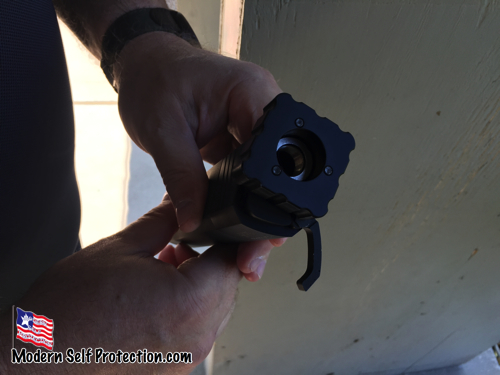
A tool is needed to pull it apart and put it back together and Silencer Co gives you the right one. Pull the ratcheting part out, use the tool to unscrew the adaptor and remove it. Put the new adaptor in and tighten it with the wrench, let go of the ratcheting lever and you are ready for the next caliber. Always be careful before handling a suppressor after use, they get really hot! Ask me how I know?
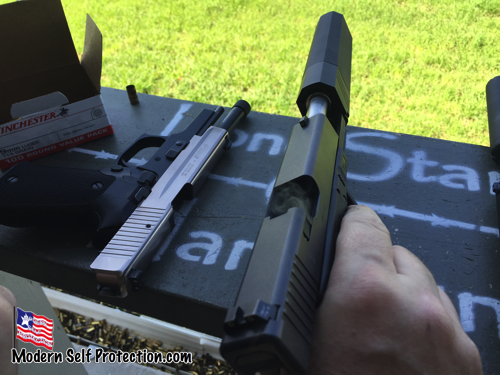
I got to shoot the suppressor on a Sig P220 .45 ACP. I wanted to see how quiet they really are. We were at a range so I had to wear hearing pro all the time (their rules). But I downloaded a decibel (dB) measurer on my iPhone called dB Volume. It totally failed me and the numbers are completely wrong. So disappointing.
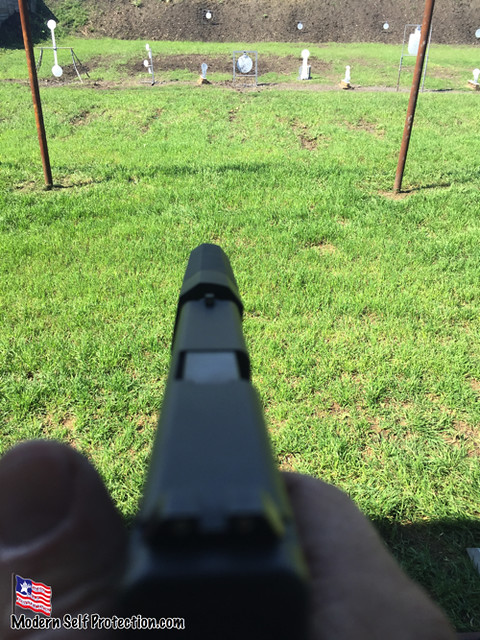
I did get to shoot the guns and have a good time. Neither of the guns had suppressor sights which is a problem. We were able to make hits buy letting the can cover the target and kind of guestamating where the front sight is compared to the target. Not impossible but really difficult.
In rifles, suppressors bring down the recoil a little, in the Sig 220 it actually felt like it recoiled more with the suppressor than without. I really didn’t enjoy shooting it with a suppressor.
Shooting the Glock 17 felt like shooting a Glock 17 with or without a suppressor. The only hard part was the sights being too small to see over the can. I wasn’t really excited, but was kind of cool.
The gun I really enjoyed and the suppressor made more fun was the little .22 Smith & Wesson M&P22c. With a Sparrow by Silencer Co it was a lot of fun. I could hear the action cycle, could here the bullet strike the dirt or the steel. .22’s are always a lot of fun, and with the suppressor it just seemed to make it more fun.
If you ever get a chance to shoot a suppressor go for it! I really won’t be buying a suppressor for a handgun any time soon. It makes the weapon big, heavy, balance awkwardly, and in some, I’ve found they throw off the point of aim by a couple inches when the suppressor is installed. I love suppressors on rifles and need to set up a trust and then buy one.
If you are going to buy a suppressor, or any NFA item (SBRs, Full Auto Weapons, Silencers, AOW, Destructive devices, etc..) using a trust is very smart. The way the law is written, if you own the NFA item you have to be in control of it always. You cannot loan it out, you are the only one that can have access to it during storage (if your spouse has the combo to your safe where they are stored, that’s a felony). To get one you have to do a background check either way, but without a trust you have to get a signature or the CLEO (Chief Law Enforcement Officer) where you live. Some won’t sign the paper for political reasons even though the law was designed for a time when the CLEO knew the people he served and could deny the purchase because you were a bad person. It was never designed for a CLEO to use as a political opinion. The trust does away with the CLEO signature requirement.
The best part of the Trust is that it is a legal entity that is there to benefit the trustees and beneficiaries (the people that own, and use the trust). While you may set up the trust just for you, you can name anyone on the trust that you want. You can add and remove people later. Anyone on the trust can possess the NFA items owned by the trust. Now that my wife is on the trust, she can have the combo to the safe again without committing felonies. She can also take the NFA items to the range without me and use them. People don’t have to be family to be on the trust that was just an example.
The other thing the trust does is live on even when members of the trust pass. If you don’t have a trust and you pass away the items then have to be transferred to someone else and they have to go through the background checks, waiting time (about 3-6 months right now), pay another tax ($200), have someone do the paper work, and have someone hold the item while the paperwork is being processed.
With the trust the other beneficiaries of the trust just continue to own, possess, and use the NFA items. The trust still owns them and nothing changes.
If you ever get the chance to shoot a suppressed weapon do it. If you get the chance, buy one, but set up a trust to put it in. One of my goals this year is to set up a trust and turn one of my Glocks into an SBR.
Stay Safe,
Ben
[AFG_gallery id=’35’]